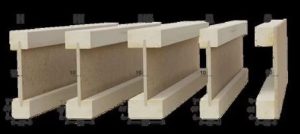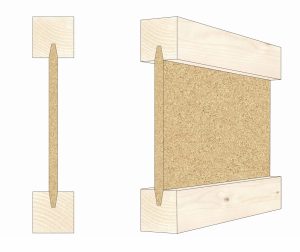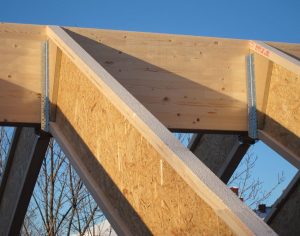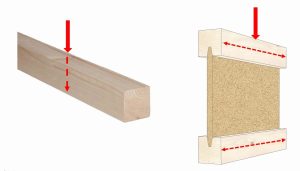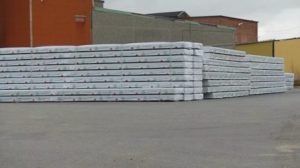Light-beams of wood, i-beams or i-joists as they are called in the US, is an Engineered Wood Product (EWP) with its roots in the USA. In a previous article here at NordicWoodJournal.com we pointed out that Sweden is far behind other forestry nations when it comes to manufacturing of engineered wood and wood components. However, i-beams seems to be the exception.
This is an article from iSkogen.se signed Torbjörn Johnsen.
I-Beams made in Sweden
In north Sweden, the company Masonite Beams are located. They are the largest manufacturer of wooden i-beams in Europe. The production started already in 1974, and today vast volumes are produced and exported to Norway, England, and several other countries.
The brand Masonite is probably familiar to most people (in a certain age anyway), thin wood-fiber sheets that also were manufactured in this factory. However, the production of wood-fiber board ended in 2012 when the company was transferred into a wood-component manufacturer owned by the Norwegian Byggma Group.
Masonite Beams in Sweden has 75 employees, and the whole group has approx. 700 today. The Norwegian particleboard manufacturer Forestia and the panel manufacturer Huntonit are also included in the Byggma Group.
Masonite Beams is a modern production plant with high capacity. The sister-site iSkogen.se got a guided tour of the plant.
Source: Svenskttra.se
I-beams – now also in Swedish houses
The use of i-beams has grown increasingly in Europe, but for the Swedish market it has been a quite anonymous product, until now. According to sales manager Daniel Wilded, also the Swedish market is growing, and sales has increased during 2021. The limitation has been to get enough wood for the production. A paradox, as the closest neighbor is a large SCA-owned sawmill, close enough to deliver the wood by forklift truck. Although prices of both sawn timber and sheet materials have increased during 2021, Masonite Beams has had a very good year.
Source: Masonitebeams.se
What is an i-beam?
An i-beam consists of two studs and a sheet that is glued between the studs. The sheet could be OSB, particleboard, or any other wood-fiber board. When using only a stud, e.g., a 2×4”, it would break at its weakest point under too much pressure, normally close to a knot or any other defect. When you split the 2×4 into two studs, and glue a sheet between them, the strength increases considerably. This even though the sheet itself doesn´t contribute to the carrying capacity.
Source: Svenskttra.se
What happens in an i-beam is that the sheet between the studs make the load from above even out along the beam, instead of pushing straight downward. In the longitudinal direction, a stud is much stronger than across. So, the design of the i-beam, with the sheet between the studs, make it very much stronger than a single stud.
Benefits of light-beams of wood
The major benefit is revealed by the name – the weight! In relation to the strength, the weight is very low compared to other similar building components like concrete, steel, solid wood, glulam, or CLT. Another benefit is that the i-beam is very thin between the studs, which gives room for more isolation in walls and floors. Also, the propagation of sound is limited in the i-beams, and thanks to the gluing they are dimensionally stable compared to components of solid wood.
Long lengths in light packages
Another advantage with the i-beam is that it could be made in long lengths and could be used in longer spans than, e.g., solid wood. Each package with i-beams, holds 39 beams in lengths up to 13 meters. In special cases, 18-meter lengths are possible to handle. In the manufacturing process the studs are finger jointed and the sheets are glued around each other, which makes long lengths possible. Despite the long lengths, each beam is still light and easy to handle.
How are i-beams used?
Masonite Beams manufacturers different types of i-beams for different parts of a building. Among other things they make i-beams for floors and roofs. These must have the highest possible strength, and the studs are therefore made of high-quality spruce wood. I-beams for walls, are made from lower wood quality studs. Together with a third strength level, Masonite Beams offer a complete building system where the i-beams are customized for each building project with the right lengths, cutting angles, and millings, all done at the factory, and ready for assembly on delivery.
The i-beams could be used in private houses as well as larger buildings such as factories, and apartment buildings.
Efficient material utilization
One important advantage for the i-beams, that Masonite Beams points out, is the low raw material consumption. On their homepage there is lots of information about environment, climate impact, and life cycle analyzes. As for an example, it´s mentioned that the raw material for the i-beams utilizes 80 % of the trees volume.
Life cycle analyzes shows that the carbon dioxide emissions related to the building process is about 50 % for a i-beams building compared to a concrete building. Compared to a CLT building, the emission is 80 % for a i-beam building. In the meantime, both i-beam- and CLT buildings stores more carbon than they let out. Something that concrete and steel doesn´t.
It may seem pointless to compare different wood-based building systems from an environmental point of view. But efficient material utilization is something that will be even more important in the future, also for the fantastic raw material that comes from the trees in the forest. The discussion about forest utilization is already going on, and even if it is obvious for us in the forest, and many others, that wood is a better material to use, there will be demands to use it efficiently, and wisely.
IKEA, as for an example, are working hard on raw material streamlining. They are talking about “Making more from less”:
“Making more from less is part of the IKEA culture, and we always use resources efficiently. Regarding wood, every piece is cut and shaped so that waste is minimized in production while maintaining quality and durability. We constantly look for new and smarter ways to design, and build our furniture to make sure our customers get the best possible product with the least impact on our planet.”
In such a future, the i-beams fits right in. The combination of solid wood in the studs, and sheet material between, make it material efficient as the combination utilizes a large share of the tree. When using a larger share of the tree, you also store more carbon so, it´s a win-win concept.
Swedish OSB is missing
During the visit at Masonite Beams, there were discussions about the sheet material in the i-beams. Particleboard from Norway and OSB from Russia is used today. There is a lack of OSB in Europe, and the prices today are four times as high as one year ago, even for large customers like Masonite Beams. The persons that we met at the factory, means that there should be a Swedish OSB producer, and they also revealed that they even consider building their own OSB factory.
A company close to its customers
When visiting Masonite Beams, you are struck by how customer oriented they are compared to other wood industries, like sawmills etc. They put a lot of effort into serving and making it simple for the customers within the building industry. The aim is to make as much as possible ready-to-use at the factory to make it as simple as possible at the construction site. That goes for handbooks, calculations-, and dimensions guides. The company also has a special department for helping customers with design, and to customize i-beam solutions for specific building projects.
Here is a film from the visit at Masonite Beams:
Film & photos: Torbjörn Johnsen where not otherwise stated






